

May Issue 2002
The North Carolina Museum of Art in Raleigh, NC, Presents an Exhibition Featuring the Culture of the Ottoman Empire
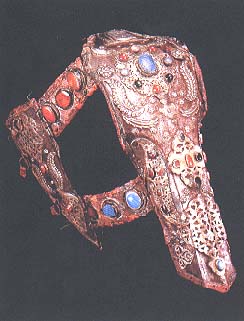 Horse's Head
Guard
Horse's Head
Guard
They conquered Constantinople a generation before Columbus set sail for the New World, and until 1923 they ruled a vast empire that straddled three continents. At its peak, the empire of the Ottomans covered modern-day Turkey and the Near East, stretched across Northern Egypt and North Africa, and extended into Europe through the Balkans and Hungary and to the walls of Vienna. As befitting one of the world's most powerful rulers, the Ottoman sultan presided over a court of unrivalled opulence, elegance and sophistication.
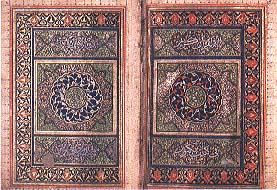
Kur'an
Celebrating the rich artistic heritage of the Ottomans and exploring Islamic aspects of this cultural tradition, the exhibition Empire Of The Sultans: Ottoman Art From The Khalili Collection presents approximately 200 objects from one of the largest collections of Ottoman Art in the world, now making its first tour of North America. The exhibition is on view at the North Carolina Museum of Art in Raleigh, NC, May 19 through July 28, 2002.
"You would have to go to the Topkapi Palace in Istanbul to see comparable treasures," said Museum Director Lawrence J. Wheeler. "Visitors will find gold and jewel-encrusted objects in the galleries, exquisite rugs and beautiful ceramics, brilliantly illuminated manuscripts and, at the other end of the spectrum, awe-inspiring weapons and armor. Perhaps few of us are familiar with the artistic wealth of this heritage or with the culture itself, and in addition to the splendors on display, the exhibition also provides us a welcome opportunity to learn more about a truly splendid civilization."
The Ottomans' cultural achievements mark one of the zeniths of art history, comparable in many ways to the finest moments of the European Renaissance, according to exhibition curator John Coffey, the Museum's deputy director for collections and programs.
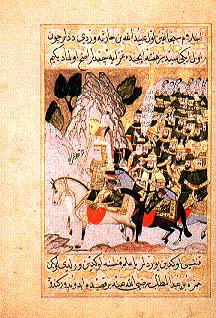
Life of the Prophet
"Their artistry surely equals, and often surpasses, works created by their European contemporaries," said Coffey. "And the tremendous breadth of this exhibition allows us to appreciate the diversity and richness of this truly imperial culture."
Though it embraced an astonishingly diverse population representing various religious backgrounds, including Christianity, the Ottoman Empire was predominately Islamic. Among the sultan's titles was caliph, the traditional spiritual leader of the Muslim world. From the court down, Ottoman art and culture in general was deeply imbued with Islam and its traditions. For that reason, the exhibition could not be more timely.
"Since Sept. 11, Americans have been asking more questions about this area of the world and about Islam and Islamic cultures in general," said Senator John Edwards. "The Museum of Art's exhibition offers opportunities to enhance our understanding of Islam's rich and varied cultural history, as well as the events happening today."
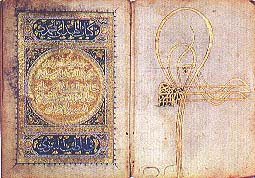 Monogram of
Süleyman
Monogram of
Süleyman
The Ottomans emerged in the late 13th century as minor Turkish princes in Anatolia, now modern Turkey. The term Ottoman derives from Osman I, the nomadic Turkish chieftain who founded the dynasty. The Ottomans became a world power in the late 15th century when they overthrew the Byzantine Empire and captured Constantinople (Istanbul) in 1453. Succeeding centuries saw expansion throughout the Middle East, into Europe and across North Africa. The golden age of the empire during the reign of Süleyman the Magnificent (1520-1566) is particularly noteworthy for its great military conquests and artistic excellence. A slow political decline, beginning in the mid-17th century, culminated with the empire's defeat and disintegration in World War I. The end came in 1923 when the Turkish Republic was declared.
"Today, the Ottoman cultural heritage is carried out by a new generation of 'Young Turks,' eager to build a nation that embodies the ideals of democracy while preserving the glories of its past," said Emin Pamucak, president of the American Turkish Association of North Carolina. "The Ottoman system of recognition and tolerance toward a multiethnic population has laid the foundation for Turkey to be a strong beacon for secular Islam."
"Empire of the Sultans" demonstrates the central role of imperial patronage and explores the originality and resilience of Ottoman artistic expression in religious, military, administrative and daily life. The exhibition and its accompanying catalogue are arranged in four thematic sections: "In the Service of God"; "Sultans, Soldiers and Clerks"; "Arts and Crafts"; and "Books, Paintings and Scripts."
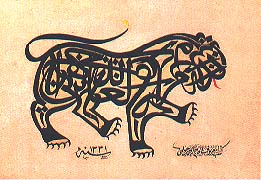 Calligraphic Lion
Calligraphic Lion
Of primary importance in the exhibition is the noblest, most venerated of Ottoman arts: calligraphy. The importance of calligraphy can be attributed in some degree to the high value placed on the studying, copying and embellishing of the Holy Kur'an, which for Muslims is the literal Word of God as revealed to the prophet Muhammad. Numerous copies of the Kur'an - exquisitely illuminated with gold-leaf medallions, scrolling arabesques and brightly colored floral motifs - are included in the exhibition, including examples from every era of Ottoman rule.
"In these wonderfully crafted books," said Coffey, "you can literally feel the power of the word. You don't have to read Arabic to appreciate the majesty and absolute conviction of the text."
Calligraphy was also used in other religious works - as mosque decorations or in the literature of dervish or mystical orders - and in secular contexts as well. Royal decrees and genealogies required elegant lettering, as did works of science and geography, such as an atlas containing charts of the Black Sea, the Mediterranean and the surrounding lands. Many of the sultans were accomplished calligraphers, and the exhibition includes several examples of their work Calligraphers' tools are also on view.
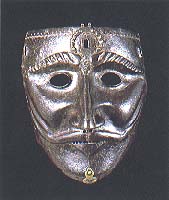 War Mask
War Mask
Weapons and armor provide insight into another aspect of Ottoman life. Formidable warriors, the Ottoman army was virtually a palace on the move, bearing silk banners embroidered with metallic threads. Warriors wearing steel masks and mail shirts rode horses that were themselves adorned with jewel-encrusted armor. In addition to these objects, the exhibition also features beautifully forged daggers and sheaths, and pistols and flintlock rifles inlaid with bone, ivory, gems and gold.
"A small, 17th century flintlock pistol is one of the few pistols from its era on view outside of Turkish state collections," said Coffey. "And it's a clever piece as well. Its inscriptions include a pun on the Persian word "kundak", meaning both "swaddling clothes" and "gunstock", implying that this pistol is 'small but deadly."'
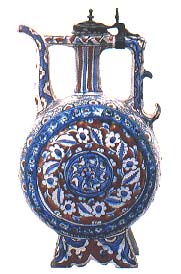
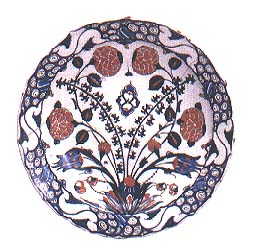
Ewer & Dish
"Empire of the Sultans" also includes a generous survey of luxurious ceramics, carpets and other textiles, many of them made for imperial use. To augment the sultan's holdings of Chinese porcelains, artisans often produced ceramic flasks, ewers and dishes in a style mimicking Ming and Yuan wares. Domestic objects in silver, brass and glass - including jugs, incense burners, coffee pots, a ladle and a scent-dropper - employ shapes and designs influenced by artistic trends from across the empire. And a sampling of rare and boldly patterned rugs represents the works of Ottoman art best-known and best-loved by Western audiences. The "star Usak" carpet in the show, dating from the late 15th or early 16th century, stands as one of the most important early carpets from western Anatolia.
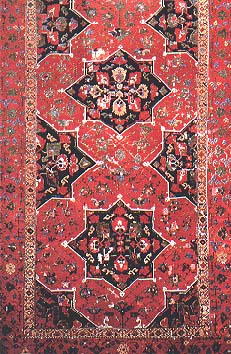 Carpet
Carpet
"In these sumptuous rugs," observed Coffey, "you can learn a great deal about the Ottomans: their love of intricate pattern and craft, their enjoyment of the world and its bounty, and their belief in the transcendence of the spirit through art. It's all here."
All of the works on view in the exhibition are from the Nasser D. Khalili Collection of Islamic Art, one of the largest collections of its kind. Assembled over the last three decades, the collection now includes more than 20,000 works of art celebrating the culture of the Islamic world. Art from the Khalili Collection has been exhibited in Geneva (1995), London (1996) and Jerusalem (1997), but the current tour marks its first exhibition in the United States.
This exhibition is organized and circulated by Art Services International, a nonprofit educational institution in Alexandria, Virginia. Presenting sponsors include the State of North Carolina. Additional support from state funds and private donations is administered by the North Carolina Museum of Art Foundation.
For more information check our NC Institutional Gallery listings, call the museum at 919/839-6262 or on the web at (www.ncartmuseum.org).
Mailing Address: Carolina Arts, P.O. Drawer
427, Bonneau, SC 29431
Telephone, Answering Machine and FAX: 843/825-3408
E-Mail: carolinart@aol.com
Subscriptions are available for $18 a year.
Carolina Arts
is published monthly by Shoestring
Publishing Company, a subsidiary of PSMG, Inc.
Copyright© 2002 by PSMG, Inc., which published Charleston
Arts from July 1987 - Dec. 1994 and South Carolina Arts
from Jan. 1995 - Dec. 1996. It also publishes Carolina Arts
Online, Copyright© 2002 by PSMG, Inc. All rights reserved
by PSMG, Inc. or by the authors of articles. Reproduction or use
without written permission is strictly prohibited. Carolina
Arts is available throughout North & South Carolina.